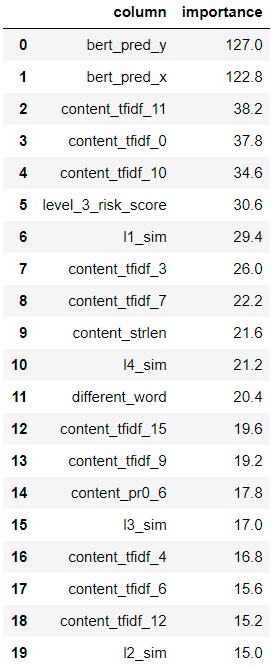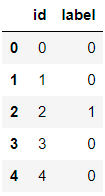1、数据集
经过前两部分的处理,我们可以得到参与建模的变量,统计类特征的处理包括在mainProcess中,bert构建的特征包括在get_bert_features中,数据预处理如下:
import warnings
warnings.simplefilter('ignore')
import re
import gc
import pickle
import numpy as np
import pandas as pd
pd.set_option('max_columns', None)
pd.set_option('max_rows', 100)
from tqdm.notebook import tqdm
%matplotlib inline
import matplotlib.pyplot as plt
import seaborn as sns
import sklearn
from sklearn.model_selection import KFold, StratifiedKFold
from sklearn.preprocessing import LabelEncoder
from sklearn.feature_extraction.text import TfidfVectorizer
from sklearn.decomposition import TruncatedSVD
from sklearn.metrics import f1_score
from lightgbm import LGBMClassifier
from sklearn.decomposition import PCA
import jieba
import jieba.posseg as pseg
import lightgbm as lgb
# 导入编码转换模块
import codecs
# 从textrank4zh模块中导入提取关键词和生成摘要的类
from textrank4zh import TextRank4Keyword, TextRank4Sentence, util
from hyperopt import fmin, tpe, hp
from hyperopt import Trials
train_path = "./data/train.csv"
test_path = "./data/test.csv"
print("数据预处理...")
train, test = mainProcess(train_path, test_path) # 获取统计类特征
train, test = get_bert_features(train, test) # 获取bert特征
最终得到的数据集如下:
train.shape
# (12000, 114)
test.shape
# (18000, 114)
2、自动调参
通常有两种常用的调参方法:网格搜索和随机搜索。每一种都有自己的优点和缺点。网格搜索速度慢,但在搜索整个搜索空间方面效果很好,而随机搜索很快,但可能会错过搜索空间中的重要点。幸运的是,还有第三种选择:贝叶斯优化。该比赛的调参环节我们使用了贝叶斯优化的一个实现,一个名为hyperopt的 Python 模块。
hyperopt的自动调参代码如下:
def hp_param(train_df):
"""基于贝叶斯的自动调参"""
data = train_df
X = data.drop(['id', 'label'], axis=1)
y = data['label']
#split
X_train, X_test, y_train, y_test = sklearn.model_selection.train_test_split(X, y, test_size=0.2, random_state=1)
train_data = lgb.Dataset(data=X_train,label=y_train)
test_data = lgb.Dataset(data=X_test,label=y_test)
# 搜索空间
space = {"max_depth": hp.randint("max_depth", 15),
"num_trees": hp.randint("num_trees", 300),
"learning_rate": hp.uniform("learning_rate", 1e-3, 5e-1),
"bagging_fraction": hp.randint("bagging_fraction", 5),
"num_leaves": hp.randint("num_leaves", 6),
}
# 参数变换
def argsDict_tranform(argsDict, isPrint=False):
argsDict["max_depth"] = argsDict["max_depth"] + 5
argsDict['num_trees'] = argsDict['num_trees'] + 150
argsDict["learning_rate"] = argsDict["learning_rate"] * 0.02 + 0.05
argsDict["bagging_fraction"] = argsDict["bagging_fraction"] * 0.1 + 0.5
argsDict["num_leaves"] = argsDict["num_leaves"] * 3 + 10
if isPrint:
print(argsDict)
else:
pass
return argsDict
def lgb_f1_score(y_hat, data):
y_true = data.get_label()
y_hat = np.round(y_hat) # scikits f1 doesn't like probabilities
return 'f1', f1_score(y_true, y_hat), True
# 模型生成器
def lightgbm_factory(argsDict):
argsDict = argsDict_tranform(argsDict)
params={'nthread': -1, # 进程数
'max_depth': argsDict['max_depth'], # 最大深度
'num_trees': argsDict['num_trees'], # 树的数量
'eta': argsDict['learning_rate'], # 学习率
'bagging_fraction': argsDict['bagging_fraction'], # 样本采样
'num_leaves': argsDict['num_leaves'], # 终点节点最小样本占比的和
'objective': 'binary',
'feature_fraction': 0.8, # 特征采样
'lambda_11': 2, # L1正则化
'lambda_12': 3, # L2正则化
'baggingseed': 100, # 随机种子,默认为100
}
params['metric'] = ['auc']
model_lgb = lgb.train(params, train_data, valid_sets=[test_data], feval=lgb_f1_score, early_stopping_rounds=10)
return get_tranformer_score(model_lgb)
# 获取损失函数
def get_tranformer_score(tranformer):
model = tranformer
prediction = model.predict(X_test, num_iteration=model.best_iteration)
return -sklearn.metrics.roc_auc_score(y_test, prediction)
# 开始调参
best = fmin(lightgbm_factory, space, algo=tpe.suggest, max_evals=6)
print('best:')
print(best)
# 得到最佳参数
print('best param')
params = argsDict_tranform(best, isPrint=True)
return params
def model_lgb_hp(train_df, params):
data = train_df
X = data.drop(['id', 'label'], axis=1)
y = data['label']
#split
X_train, X_test, y_train, y_test = sklearn.model_selection.train_test_split(X, y, test_size=0.2, random_state=1)
train_data = lgb.Dataset(data=X_train,label=y_train)
test_data = lgb.Dataset(data=X_test,label=y_test)
#train
gbm_model = LGBMClassifier(boosting_type='gbdt', **params)
gbm_model.fit(X_train, y_train, eval_set=[(X_train, y_train), (X_test, y_test)], eval_metric='AUC', early_stopping_rounds=10)
pickle.dump(gbm_model, open("model", "wb"))
print("lgb已保存成文件model")
调用如上实现可以获得最优参数best_params:
best_params = hp_param(train)
model_lgb_hp(train, best_params)
3、训练LGB模型
采用五折交叉验证训练模型,最终的预测结果是五个模型预测结果的平均值。
def train_model(train, test):
ycol = 'label'
feature_names = list(filter(lambda x: x not in [ycol, 'id'], train.columns))
# 贝叶斯调参 A榜f1: 0.95887806
model = lgb.LGBMClassifier(objective='binary',
boosting_type='gbdt',
learning_rate=0.05,
n_estimators=1000,
max_depth=15,
num_leaves=13,
subsample=0.6,
feature_fraction=0.8,
reg_alpha=2,
reg_lambda=3,
random_state=2021,
is_unbalance=True,
metric='auc')
oof = []
prediction = test[['id']]
prediction[ycol] = 0
df_importance_list = []
kfold = StratifiedKFold(n_splits=5, shuffle=True, random_state=2021)
for fold_id, (trn_idx, val_idx) in enumerate(kfold.split(train[feature_names], train[ycol])):
X_train = train.iloc[trn_idx][feature_names]
Y_train = train.iloc[trn_idx][ycol]
X_val = train.iloc[val_idx][feature_names]
Y_val = train.iloc[val_idx][ycol]
print('\nFold_{} Training ================================\n'.format(fold_id+1))
lgb_model = model.fit(X_train,
Y_train,
eval_names=['train', 'valid'],
eval_set=[(X_train, Y_train), (X_val, Y_val)],
verbose=100,
eval_metric='auc',
early_stopping_rounds=50)
pred_val = lgb_model.predict_proba(X_val, num_iteration=lgb_model.best_iteration_)
df_oof = train.iloc[val_idx][['id', ycol]].copy()
df_oof['pred'] = pred_val[:,1]
oof.append(df_oof)
pred_test = lgb_model.predict_proba(test[feature_names], num_iteration=lgb_model.best_iteration_)
prediction[ycol] += pred_test[:,1] / kfold.n_splits
df_importance = pd.DataFrame({
'column': feature_names,
'importance': lgb_model.feature_importances_,
})
df_importance_list.append(df_importance)
del lgb_model, pred_val, pred_test, X_train, Y_train, X_val, Y_val
gc.collect()
df_oof = pd.concat(oof)
df_importance = pd.concat(df_importance_list)
df_importance = df_importance.groupby(['column'])['importance'].agg(
'mean').sort_values(ascending=False).reset_index()
print(df_importance)
return df_oof, prediction
模型的输出结果:
df_oof, prediction, df_importance = train_model(train, test)
'''
Fold_1 Training ================================
Training until validation scores don't improve for 50 rounds
[100] train's auc: 0.998856 valid's auc: 0.992418
Early stopping, best iteration is:
[135] train's auc: 0.999204 valid's auc: 0.992803
Fold_2 Training ================================
Training until validation scores don't improve for 50 rounds
[100] train's auc: 0.99881 valid's auc: 0.994931
Early stopping, best iteration is:
[97] train's auc: 0.998795 valid's auc: 0.995108
Fold_3 Training ================================
Training until validation scores don't improve for 50 rounds
[100] train's auc: 0.998976 valid's auc: 0.985797
Early stopping, best iteration is:
[51] train's auc: 0.998004 valid's auc: 0.986633
Fold_4 Training ================================
Training until validation scores don't improve for 50 rounds
[100] train's auc: 0.999213 valid's auc: 0.988753
Early stopping, best iteration is:
[82] train's auc: 0.999027 valid's auc: 0.989578
Fold_5 Training ================================
Training until validation scores don't improve for 50 rounds
[100] train's auc: 0.998795 valid's auc: 0.994695
Early stopping, best iteration is:
[76] train's auc: 0.998359 valid's auc: 0.995042
'''
特征重要性:

4、搜索最优划分阈值
由于数据的正负样本并不平衡,直接使用0.5作为正样本的划分条件不够合理,这里结合五折交叉验证在训练集上的预测结果,搜索使得f1 score达到最大的划分阈值,搜索过程如下,测试集使用最优划分阈值来得到预测标签:
def search_best_split(df_oof, prediction):
i_bst = 0
bst = 0
for i in np.arange(0.1, 1, 0.05):
df_oof['pred_label'] = df_oof['pred'].apply(lambda x: 1 if x >= i else 0)
score = f1_score(df_oof['label'], df_oof['pred_label'])
print(i, 'f1_score:', score)
if score> bst:
i_bst = i
bst = score
print('best split point: {}, best f1-score: {}'.format(i_bst, bst))
prediction['label'] = prediction['label'].apply(lambda x: 1 if x >= i_bst else 0)
print(prediction['label'].value_counts())
return prediction[['id', 'label']]
输出结果如下:
result = search_best_split(df_oof, prediction)
'''
0.1 f1_score: 0.7603853100541843
0.15000000000000002 f1_score: 0.8142394822006473
0.20000000000000004 f1_score: 0.8392498325519089
0.25000000000000006 f1_score: 0.8588114050154587
0.30000000000000004 f1_score: 0.8713286713286713
0.3500000000000001 f1_score: 0.8830616583982991
0.40000000000000013 f1_score: 0.8921533500537442
0.45000000000000007 f1_score: 0.8991291727140784
0.5000000000000001 f1_score: 0.907957462412908
0.5500000000000002 f1_score: 0.9113082039911308
0.6000000000000002 f1_score: 0.9134328358208955
0.6500000000000001 f1_score: 0.9170731707317074
0.7000000000000002 f1_score: 0.919000757002271
0.7500000000000002 f1_score: 0.9223115193264447
0.8000000000000002 f1_score: 0.9242718446601942
0.8500000000000002 f1_score: 0.9224714679260133
0.9000000000000002 f1_score: 0.9174385823600484
0.9500000000000003 f1_score: 0.797088262056415
best split point: 0.8000000000000002, best f1-score: 0.9242718446601942
0 16082
1 1918
'''
最终的预测结果如下:
result.head()

至此,完成比赛。
此外,比赛过程中还有一些发现可以记录下来:
- 适当提高训练bert的epoch可以提高预测结果,但epoch较多时反而变得不好,考虑可能的原因是:适当的epoch可以使得模型得到充分的训练,但是过多epoch会使模型在训练集上拟合的太好,导致泛化性能下降,应该还是bias and variance的问题。
- 通过模型集成和调参确实可以一定程度上提升预测效果。
- 比赛中构造特征是基于Wide&Deep的思路,统计类特征可视为Wide部分,bert输出的特征可视为Deep部分,Wide部分的主要作用是让模型具有较强的“记忆能力”,Deep部分的主要作用是让模型具有“泛化能力”。不过Wide部分和Deep部分没有一起训练,而是先将Deep部分训练好,最后通过LGB融合后作分类。
- bert处理文本分类任务,效果确实非常好(sentence pair bert的结果直接用于预测在线上可以达到0.9528,LGB模型在线上的最好成绩是0.9588),不过对计算资源要求也很高,单机基本跑不动,白嫖了google的GPU才把结果跑出来。
如有更好的处理方式,请不吝指教,非常感谢。